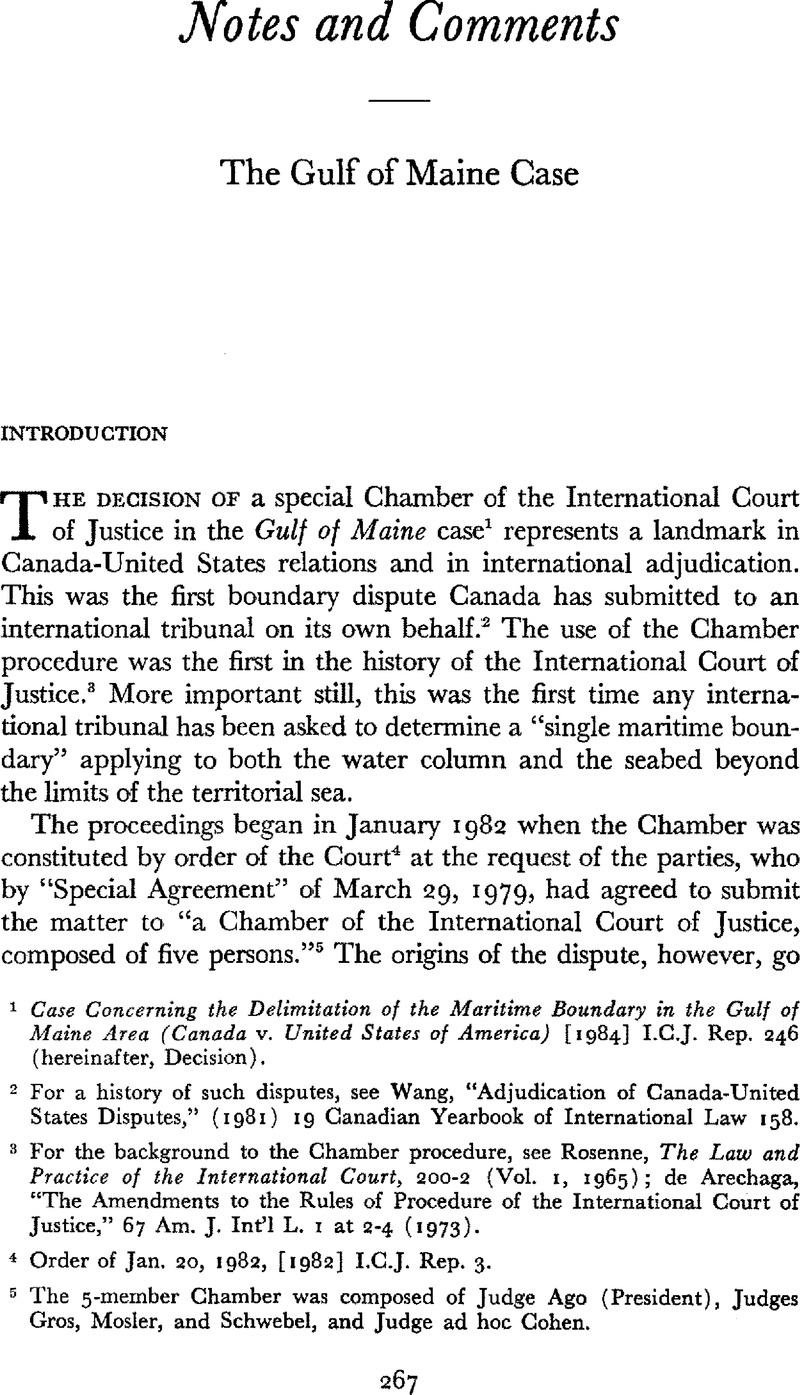No CrossRef data available.
Article contents
The Gulf of Maine Case
Published online by Cambridge University Press: 09 March 2016
Abstract

- Type
- Notes and Comments / Notes et commentaires
- Information
- Canadian Yearbook of International Law/Annuaire canadien de droit international , Volume 22 , 1985 , pp. 267 - 290
- Copyright
- Copyright © The Canadian Council on International Law / Conseil Canadien de Droit International, representing the Board of Editors, Canadian Yearbook of International Law / Comité de Rédaction, Annuaire Canadien de Droit International 1985
References
1 Case Concerning the Delimitation of the Maritime Boundary in the Gulf of Maine Area (Canada v. United States of America) [1984] I.C.J. Rep. 246 (hereinafter, Decision).
2 For a history of such disputes, see Wang, , “Adjudication of Canada-United States Disputes,” (1981) 19 Canadian Yearbook of International Law 158.Google Scholar
3 For the background to the Chamber procedure, see Rosenne, The Law and Practice of the International Court, 200–2 (Vol. 1, 1965); de Arechaga, , “The Amendments to the Rules of Procedure of the International Court of Justice,” 67 Am. J. Int’l L. 1 at 2–4 (1973).CrossRefGoogle Scholar
4 Order of Jan. 20, 1982, [1982] I.C.J. Rep. 3.
5 The 5-member Chamber was composed of Judge Ago (President), Judges Gros, Mosler, and Schwebel, and Judge ad hoc Cohen.
6 Canada’s jurisdiction was extended on Jan. 1, 1977; Fishing Zones of Canada (Zones 4 and 5) Order, P.C. 1977–1. United States jurisdiction was extended on Mar. 1, 1977; United States Fishery Conservation and Management Act, 1976, 16 U.S. Code s. 1801 (1976).
7 Canadian Memorial, para. 2.
8 For background on the link between the fisheries agreement and the boundary, see McRae, , “Delimitation of the Maritime Boundary in the Gulf of Maine Area,” (1979) 11 Canadian Yearbook of International Law 292.Google Scholar
9 Memorials were filed on Sept. 27, 1982, Counter-memorials on June 28, 1983, and Replies on Dec. 12, 1983.
10 Supra note 1, at p. 360.
11 The selection of Point A avoided having the Chamber determine the sovereignty of Machias Seal Island.
12 A triangle “was chosen simply as a convenient neutral technique that accomplishes the task of indicating clearly where the adjudicated boundary is to end. The triangle encompasses the terminal points of the published boundary claims of both Parties, as well as the arcs of circles defining the seaward limit of the 200-mile fishing zone of each Party between the two terminal points”: Canadian Memorial, para. 12.
13 Canadian Memorial, para. 346.
14 Canadian Counter-Memorial, para. 611.
15 For an outline of the arguments at the end of the written phase of the proceedings, see McRae, , “The Gulf of Maine Case: The Written Proceedings,” (1983) 21 Canadian Yearbook of International Law 266.Google Scholar
16 Canadian Memorial, para. 278. The United States formulation of the “fundamental norm” varied only slightly : United States Memorial, para. 8.
17 Canadian Counter-Memorial, para. 545.
18 Ibid., para. 549.
19 The “distance principle” was referred to by the Court in the Tunisia-Libya Continental Shelf case [1982] I.C.J. Rep. 18, 48–49.
20 In this regard, Canada described the “Northeast Channel” as a “superficial topographic feature,” Canadian Memorial, para. 84.
21 Canadian Reply, para. 242.
22 This direction was identified as 54°, which corresponded with various lines drawn from points on the United States coast to points on the Canadian coast: see United States Memorial, Figure #26.
23 The United States sought to exclude the coasts of the Bay of Fundy on the ground that they did not “face either the Gulf of Maine or the area seaward of the Gulf.” United States Counter Memorial, para. 33.
24 In this regard the United States invoked the Grisbadarna case, where the arbitral tribunal had adjusted the boundary to avoid dividing a fishing bank: United States Memorial, para. 180.
25 United States Memorial, para. 135.
26 Special Agreement, Article 2(2).
27 Ibid., Art. 2(3). The expert was Commander Peter Beazley (United Kingdom).
28 Decision, paras. 26–27.
29 Verbatim Record, CI/CR 84/11, at 60, and annexes.
30 Decision, at p. 363.
31 Ibid.
32 Decision, para. 31.
33 Ibid., para. 36.
34 Ibid., para. 37.
35 Ibid., para. 41.
36 Ibid., para. 39.
37 Ibid., para. 44.
38 Ibid., para. 45.
39 Ibid., para. 46.
40 Ibid., para. 48.
41 Ibid., para. 53.
42 Ibid., para. 168.
43 Ibid., para. 193 (emphasis added).
44 Ibid., para. 137.
45 Ibid., paras. 150–52.
46 Ibid., para. 111.
47 Ibid., para. 81.
48 Ibid., para. 86.
49 Ibid., para. 106.
50 Ibid., para. 110.
51 Ibid., para. 112.
52 Ibid., para. 150.
53 Ibid., para. 153.
54 Ibid., para. 176.
55 Ibid., para. 184.
56 Ibid., para. 192.
57 Ibid., para. 193.
58 Ibid., para. 195.
59 Ibid., para. 196.
60 Ibid., para. 199.
61 Ibid., para. 201.
62 Ibid., para. 213.
63 Ibid., para. 216.
64 Ibid., para. 217.
65 Ibid., para. 220.
66 Ibid., para. 221.
67 Ibid., para. 222.
68 Ibid., para. 224.
69 Ibid.
70 Ibid., para. 335.
71 Ibid., para. 237.
72 Ibid., para. 240.
73 Ibid., para. 241.
74 Ibid., para. 157.
75 Ibid., para. 112.
76 Ibid.
77 Ibid.
78 Ibid., para. 89.




